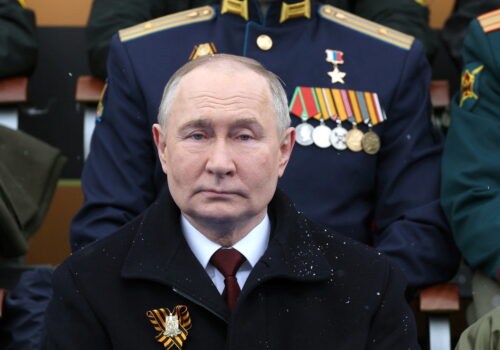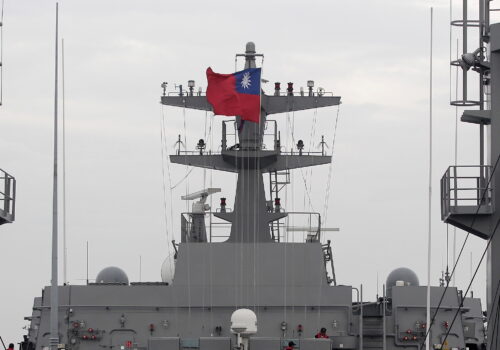Is China or Russia the bigger threat to the United States? There’s a clear answer.
The Trump administration has made known that it views China as the top national security priority. Beijing is, as US Defense Secretary Pete Hegseth described it, the “sole pacing threat,” receiving first call on resources and attention from the US Department of Defense. Some members of the administration’s national security team have built their reputations on a “singular focus on China,” at the same time arguing that Europe must fend for itself in a new era of great power competition.
But this “China first” approach to US foreign policy did not start with the Trump administration. At least since the Obama administration, those arguing that China poses the greatest threat to the United States have held sway in Washington. They’re wrong. Here’s why.
Any threat assessment must begin with sizing up challenges to the United States’ vital interests. In other words, US policymakers should look first at those threats that directly endanger the country’s national existence, population, territory, economic prosperity, and political institutions. Across the board, Russia comes in first in this calculus.
With 5,580 nuclear warheads to China’s roughly 600, Russia is vastly superior as a nuclear power. Self-sufficient in energy and agriculture, Russia has opened new markets abroad and actually grown its economy despite severe international sanctions in the past few years. For the past decade, Russia has launched disinformation campaigns designed to influence US presidential and congressional elections, posing a direct threat to US institutions. Unlike China, which hasn’t fought a war since its border clashes with Vietnam in 1979, Russia’s military has extensive recent combat experience in Georgia, Syria, and Ukraine. While China has rattled its saber, Russia has returned major theater war to the European continent on the largest scale since 1945, with hundreds of thousands killed and injured and whole cities destroyed outright.
Where Putin sees weakness, he has shown repeatedly that he will act.
And Europe matters to the United States. The combined gross domestic product (GDP) for the European Union (EU) and non-EU NATO allies Norway and the United Kingdom in 2024 was $22.5 trillion to China’s $18.5 trillion. The US-EU economic partnership is the largest bilateral trade relationship in the world, accounting for more than 40 percent of global GDP. US-Europe goods trade totaled an estimated $1.2 trillion in 2023, 25 percent more than US goods trade with China. US foreign direct investment in Europe is almost four times greater than in Asia-Pacific countries. According to the US Chamber of Commerce, “no two other regions in the world are as deeply integrated as the US and Europe.” The loss or disruption of these trade relations would have an immediate and drastic impact on the US and global economies.
Europe includes thirty of the United States’ treaty allies, supporting Washington in international organizations such as the United Nations and on the battlefield, where thousands of European soldiers were killed and wounded in Iraq and Afghanistan. The United States is much stronger militarily, economically, and diplomatically with these allies than without them—and abandoning historic allies in Europe would surely discomfit US treaty allies in the Pacific. Despite criticism by US conservatives, the United States’ NATO allies spent $485 billion on defense in 2024—more than four times what Russia spent and collectively exceeding 2 percent of their GDP. Those figures are sure to grow. To be sure, there are readiness and capability gaps that need to be addressed. Coordinating defense policies and standards across dozens of polities is a challenge that confronts the United States in the Pacific as well. Even so, Europe also invests heavily in US defense industries, with sales of the F-35 fighter, Patriot air defense system, M1-series main battle tanks, and other defense articles booming.
With continued US support and leadership, Europe can stand against the Russian threat, providing the bulk of the manpower, funding, and combat platforms needed to deter and prevent a wider war in Europe. But that strength depends on a firm transatlantic link, and above all, on US extended nuclear deterrence. Should the US disengage, a wider war in Europe is not only possible but likely, directly threatening US national security, as well as the global economy and the stability of the international system.
Could that really happen? Despite severe losses, the Russian military is quickly reconstituting itself, and by some measures it is now larger than before its February 2022 full-scale invasion of Ukraine. Russian President Vladimir Putin continues to frame the conflict as a war with NATO and the West, not just Ukraine. Russian sabotage and cyberattacks in Europe have risen sharply since 2022. For years, national security experts downplayed the likelihood of large-scale Russian aggression in Europe, even after Moscow invaded Georgia in 2008 and annexed Crimea and launched its war in the Donbas in 2014. They were proven wrong with a vengeance. Where Putin sees weakness, he has shown repeatedly that he will act.
In prioritizing US national security needs, it’s also important not to exaggerate or overstate the threat from China. Despite the protestations from US admirals that China’s People’s Liberation Army Navy has more ships, the US Navy is far stronger. It has twice the surface tonnage as China’s navy, a huge advantage in vertical missile launchers, and many more destroyers, cruisers, and frigates (as opposed to the smaller coastal patrol ships which constitute much of the Chinese fleet). US Navy nuclear aircraft carriers and nuclear attack submarines far outnumber China’s, while US naval technology is more advanced. This US naval advantage is even greater when factoring in the allied navies of Japan, Australia, South Korea, and the Philippines. US airpower is similarly dominant, with many more fourth- and fifth-generation combat aircraft and vastly superior C4ISR—what is often called the “nervous system” of a military that includes command, control, communications, computers, intelligence, surveillance, and reconnaissance. This superiority is, again, augmented by allies. Within range of its land-based missile systems, China is a dangerous opponent. In blue water, the United States and its allies are far more capable.
Moreover, China is disadvantaged by a lack of strong allies in its neighborhood and by a dependence on maritime trade for its economic survival—trade that would be swiftly interdicted in time of war. Indeed, 80 percent of China’s oil imports pass through the Strait of Malacca, which is far beyond the reach of the Chinese navy. What’s more, China is ringed by states with significant militaries backed up by US air and maritime power. With a stagnant economy and serious internal problems, China can ill afford a major regional conflict it is almost certain to lose.
To be sure, China does pose important challenges to the United States and its allies and partners today. None of these issues should be ignored. Moreover, as a major and growing power, China’s ability and willingness to threaten the United States could increase in the future. Beijing will seek to impose its influence on its neighbors where it can through political, economic, and even military threats. But a major war would only put the survival of the Chinese Communist Party at grave risk.
The United States is a global power—still the only economic and military superpower in the world. It is both unnecessary and imprudent to place all its strategic eggs in one basket. An overemphasis on the Asia-Pacific, leaving Europe to go it alone, risks a failure of deterrence with unacceptable consequences. Both Europe and the Asia-Pacific are important. Both deserve real attention and commitment in Washington.
Richard D. Hooker, Jr., is a senior fellow with the Transatlantic Security Initiative within the Atlantic Council’s Scowcroft Center for Strategy and Security and a senior associate with the Belfer Center at the Harvard Kennedy School. He is a former National Security Council senior director for Europe and Russia.
Further reading
Tue, Apr 29, 2025
Putin announces ceasefire to protect Moscow parade from Ukrainian attack
UkraineAlert By Peter Dickinson
Vladimir Putin is now so emboldened by Western weakness that he believes he can personally pause the war to host a military parade on Red Square before resuming his invasion three days later, writes Peter Dickinson.
Tue, Apr 29, 2025
The United States needs a victory plan for the Indo-Pacific
Issue Brief By Brian Kerg
The United States remains focused on planning for a short, sharp war with China. But a potential conflict will almost certainly become a long war of attrition.
Thu, Apr 24, 2025
Defending Taiwan means mobilizing society, not just the military
Issue Brief By Marvin J. Park
Taiwan is under unprecedented pressure from the People’s Republic of China (PRC), facing coordinated threats on multiple fronts.
Image: The Russian national flag flies in front of the Great Hall of the People before a welcoming ceremony for Russian Prime Minister Mikhail Mishustin in Beijing, China, May 24, 2023. REUTERS/Thomas Peter/Pool/File Photo



